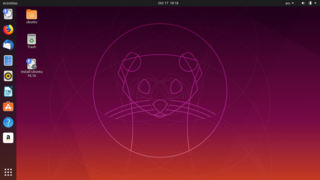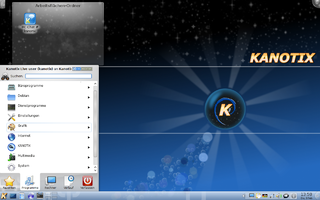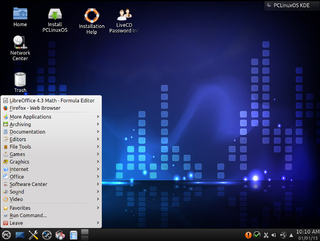Related Research Articles

A Linux distribution is an operating system made from a software collection that is based upon the Linux kernel and, often, a package management system. Linux users usually obtain their operating system by downloading one of the Linux distributions, which are available for a wide variety of systems ranging from embedded devices and personal computers to powerful supercomputers.

Windows 98 is an operating system developed by Microsoft as part of its Windows 9x family of Microsoft Windows operating systems. It is the successor to Windows 95, and was released to retail on June 25, 1998. Like its predecessor, it is a hybrid 16-bit and 32-bit monolithic product with the boot stage based on MS-DOS.

KNOPPIX is an operating system based on Debian designed to be run directly from a CD / DVD or a USB flash drive, one of the first of its kind for any operating system. Knoppix was developed by, and named after, Linux consultant Klaus Knopper. When starting a program, it is loaded from the removable medium and decompressed into a RAM drive. The decompression is transparent and on-the-fly.

A live CD is a complete bootable computer installation including operating system which runs directly from a CD-ROM or similar storage device into a computer's memory, rather than loading from a hard disk drive. A Live CD allows users to run an operating system for any purpose without installing it or making any changes to the computer's configuration. Live CDs can run on a computer without secondary storage, such as a hard disk drive, or with a corrupted hard disk drive or file system, allowing data recovery.

Damn Small Linux is a computer operating system for the x86 family of personal computers. It is free and open source software under the terms of the GNU GPL and other free and open source licenses. It was designed to run graphical applications on older PC hardware—for example, machines with 486/early Pentium processors and very little memory. DSL is a Live CD with a size of 50 MB. What originally started as an experiment to see how much software could fit in 50 MB eventually became a full-fledged Linux distribution. It can be installed on storage media with small capacities, like bootable business cards, USB flash drives, various memory cards, and Zip drives.

A USB flash drive is a data storage device that includes flash memory with an integrated USB interface. It is typically removable, rewritable and much smaller than an optical disc. Most weigh less than 30 g (1 oz). Since first appearing on the market in late 2000, as with virtually all other computer memory devices, storage capacities have risen while prices have dropped. As of March 2016, flash drives with anywhere from 8 to 256 gigabytes (GB) were frequently sold, while 512 GB and 1 terabyte (TB) units were less frequent. As of 2018, 2 TB flash drives were the largest available in terms of storage capacity. Some allow up to 100,000 write/erase cycles, depending on the exact type of memory chip used, and are thought to last between 10 and 100 years under normal circumstances.

Kanotix, also referred to as KANOTIX, is an operating system based on Debian, with advanced hardware detection. It can run from an optical disc drive or other media i.e. USB-stick without using a hard disk drive.
A patch is a set of changes to a computer program or its supporting data designed to update, fix, or improve it. This includes fixing security vulnerabilities and other bugs, with such patches usually being called bugfixes or bug fixes, and improving the functionality, usability or performance.
Installation of a computer program, is the act of making the program ready for execution. Installation refers to the particular configuration of a software or hardware with a view to making it usable with the computer. A soft or digital copy of the piece of software (program) is needed to install it. There are different processes of installing a piece of software (program). Because the process varies for each program and each computer, programs often come with an installer, a specialised program responsible for doing whatever is needed for the installation. Installation may be part of a larger software deployment process.

PCLinuxOS, often shortened to PCLOS, is an x86-64 Linux distribution, with KDE Plasma Desktop, MATE and XFCE as its default user interfaces. It is a primarily free software operating system for personal computers aimed at ease of use. It is considered a rolling release.

The Personal Jukebox was the first consumer hard drive-based digital audio player. Introduced in 1999, it preceded the Apple iPod, SanDisk Sansa, and other similar players. It was designed and developed by Compaq Research starting in May 1998. Compaq did not release the player themselves, but licensed the design to HanGo Electronics Co., Ltd. of South Korea.

The USB mass storage device class is a set of computing communications protocols, specifically a USB Device Class, defined by the USB Implementers Forum that makes a USB device accessible to a host computing device and enables file transfers between the host and the USB device. To a host, the USB device acts as an external hard drive; the protocol set interfaces with a number of storage devices.

U3 was a joint venture between SanDisk and M-Systems, producing a proprietary method of launching Windows software from special USB flash drives. Flash drives adhering to the U3 specification are termed "U3 smart drives". U3 smart drives come preinstalled with the U3 Launchpad, which looks similar to the Windows OS start menu and controls program installation. Applications that comply with U3 specifications are allowed to write files or registry information to the host computer, but they must remove this information when the flash drive is ejected. Customizations and settings are instead stored with the application on the flash drive.

Windows Preinstallation Environment is a lightweight version of Windows used for the deployment of PCs, workstations, and servers, or troubleshooting an operating system while it is offline. It is intended to replace MS-DOS boot disks and can be booted via USB flash drive, PXE, iPXE, CD-ROM, or hard disk. Traditionally used by large corporations and OEMs, it is now widely available free of charge via Windows Automated Installation Kit (WAIK).

Mozilla Firefox, Portable Edition is a repackaged version of Mozilla Firefox created by John T. Haller. The application allows Firefox to be run from a USB flash drive, CD-ROM, or other portable device on any Windows computer or Linux/Unix computer running Wine. The program does not require Firefox to be installed on the computer, nor does it leave personal information on the computer or interfere with any installed versions of Firefox, however, installation on the computer's data storage device is possible.
The NSLU2 is a network-attached storage (NAS) device made by Linksys introduced in 2004 and discontinued in 2008. It makes USB flash memory and hard disks accessible over a network using the SMB protocol. It was superseded mainly by the NAS200 and in another sense by the WRT600N and WRT300N/350N which both combine a Wi-Fi router with a storage link.

Linux Mint is a community-driven Linux distribution based on Ubuntu or Debian that strives to be a 'modern, elegant and comfortable operating system which is both powerful and easy to use'. Linux Mint provides full out-of-the-box multimedia support by including some proprietary software, such as multimedia codecs, and comes bundled with a variety of free and open-source applications.
Secure USB flash drives protect the data stored on them from access by unauthorized users. USB flash drive products have been on the market since 2000, and their use is increasing exponentially. As both consumers and businesses have increased demand for these drives, manufacturers are producing faster devices with greater data storage capacities.

XigmaNAS is a network-attached storage (NAS) server software with a dedicated management web interface. It is free software under the terms of the Simplified BSD license.

BackSlash Linux is an Ubuntu and Debian-based operating system developed in India by Kumar Priyansh for AMD64 and Intel x64-based personal computers. It is based on free software and every release of the operating system is named after the characters of the 2013 Disney film Frozen. Since the third major release, BackSlash Linux Olaf, BackSlash Linux has used its own custom version of KDE, called the BackSlash Shell, as the default user desktop.
References
- ↑ "Fun Facts about Project Dakota". Archived from the original on 30 January 2008. Retrieved 5 January 2008.
- ↑ "Bugs in version 0.1AB" . Retrieved 5 January 2008.[ dead link ]
- ↑ "Fun Facts about Project Dakota". Archived from the original on 30 January 2008. Retrieved 5 January 2008.
- ↑ "0.1AB Is live!" . Retrieved 5 January 2008.[ dead link ]
- ↑ "0.1CS Is live!" . Retrieved 13 January 2008.[ dead link ]
- ↑ "Here comes 0.2!" . Retrieved 15 July 2008.[ permanent dead link ]